In the dynamic realm of Russia crypto, recent data from the Central Bank reveals a noteworthy shift in the behaviour of crypto traders. The report highlights a decline in citizens engaging with major overseas trading platforms, departing from the conventional centralised exchanges. As sanctions loom over Russia and crypto regulations tighten, nuanced patterns of preferences emerge among crypto enthusiasts.
The Decline in Centralized Exchanges
Russia’s Central Bank reports a substantial drop in citizens trading crypto on major overseas platforms during the second and third quarters of 2023. Visits to the world’s largest cryptocurrency trading platforms have dwindled, accompanied by a noticeable decrease in Russian-owned cryptocurrency flowing through these exchanges. Intriguingly, crypto traders are now pivoting away from centralised exchanges, embracing P2P and over-the-counter (OTC) markets.
Day trading crypto has undergone a significant transformation, with P2P transactions emerging as Russians’ primary channel for acquiring crypto assets. A crypto security provider suggests that a staggering $296 million worth of P2P crypto trades are available daily in Russia. The average monthly volume of Russian P2P crypto transactions has surged by 53.9%. Therefore, illustrating a growing reliance on decentralised and peer-driven trading mechanisms.
Russia Crypto: Navigating Sanctions and Challenges
The international crypto landscape has been challenging for Russia-based traders. Many major exchanges, reacting to US- and EU-led sanctions, have barred Russian crypto traders. Nevertheless, reports suggest that some traders are circumventing these restrictions, using loopholes to continue utilising overseas centralised exchanges. Notably, Binance’s announcement of a complete withdrawal from Russia reflects crypto businesses’ challenges in navigating geopolitical uncertainties.
The Central Bank, while cautioning against “risky” alternative centralised exchanges, acknowledges that the decline in crypto trading may not be solely attributed to sanctions. Despite external challenges, Russian visitors’ share on centralized exchanges dropped from 5.8% to 4.9% in FY2023’s second and third quarters.
In conclusion, in the complex landscape of Russia crypto, the trend toward P2P trading signifies a strategic shift among crypto traders. The crypto community navigates uncertainties as geopolitical challenges persist, embracing decentralised models while adapting to evolving regulatory landscapes. The centralized exchange activity decrease reflects sanctions impact and but a diverse reaction to shifting crypto preferences amid the bear market.











COMMENTS